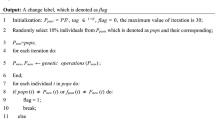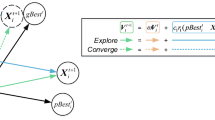Abstract
Tracking changing Pareto front (PF) in the objective space and Pareto set (PS) in the decision space is an important task in dynamic multi-objective optimization (DMO). Similarly, maintaining population diversity and reusing previous evolutionary information are useful to explore promising regions and to find high-quality solutions quickly in time-varying environments. To this end, a sliding time window based on parallel computing (STW-PC) is introduced in the present study. In the STW-PC, obtained time-sequence solution sets aim to preserve the diversity and facilitate a fast convergence since problems in successive time/environments are usually related. The parallel computing method is also employed to reduce the computational time. The STW-PC is incorporated into a multi-objective evolutionary algorithm and is compared with two competitors on 12 dynamic multi-objective optimization problems. The results show that the STW-PC can both improve the tracking performance of the selected algorithm in different degrees of changes, and significantly reduce the calculation time compared with transfer learning.
Access this chapter
Tax calculation will be finalised at checkout
Purchases are for personal use only
Similar content being viewed by others
References
Cruz, C., González, J., Pelta, D.: Optimization in dynamic environments: a survey on problems, methods and measures. Soft. Comput. 15(7), 1427–1448 (2011)
Nguyen, S., Zhang, M., Johnston, M., et al.: Automatic design of scheduling policies for dynamic multi-objective job shop scheduling via cooperative coevolution genetic programming. IEEE Trans. Evol. Comput. 18(2), 193–208 (2013)
Yan, X., Cai, B., Ning, B., et al.: Moving horizon optimization of dynamic trajectory planning for high-speed train operation. IEEE Trans. Intell. Transp. Syst. 17(5), 1258–1270 (2015)
Yazici, A., Kirlik, G., Parlaktuna, O., et al.: A dynamic path planning approach for multirobot sensor-based coverage considering energy constraints. IEEE Trans. Cybern. 44, 305–314 (2013)
Karatas, M.: A dynamic multi-objective location-allocation model for search and rescue assets. Eur. J. Oper. Res. 288(2), 620–633 (2021)
Fan, Q., Wang, W., Yan, X.: Multi-objective differential evolution with performance-metric-based self-adaptive mutation operator for chemical and biochemical dynamic optimization problems. Appl. Soft Comput. 59, 33–44 (2017)
Jiang, M., Huang, Z., Qiu, L., et al.: Transfer learning-based dynamic multiobjective optimization algorithms. IEEE Trans. Evol. Comput. 22(4), 501–514 (2018)
Tanabe, R., Ishibuchi, H.: A review of evolutionary multi-modal multi-objective optimization. IEEE Trans. Evol. Comput. 24(1), 193–200 (2019)
Yan, W., Chang, J., Shao, H.: Least square SVM regression method based on sliding time window and its simulation. J. Shanghai Jiaotong Univ. 38(4), 524–526 (2004)
Fan, Q., Yan, X., Zhang, Y., et al.: A variable search space strategy based on sequential trust region determination technique. IEEE Trans. Cybern. PP, 1–3 (2019)
Helbig, M., Engelbrecht, A.: Benchmark functions for CEC 2015 special session and competition on dynamic multi-objective optimization. Technical report (2015)
Zhang, Q., Yang, S., Jiang, S., et al.: Novel prediction strategies for dynamic multi-objective optimization. IEEE Trans. Evol. Comput. 24(2), 260–274 (2019)
Muruganantham, A., Tan, K., Vadakkepat, P.: Evolutionary dynamic multiobjective optimization via Kalman filter prediction. IEEE Trans. Cybern. 46(12), 2862–2873 (2015)
Akrida, E., Mertzios, G., Spirakis, P., et al.: Temporal vertex cover with a sliding time window. J. Comput. Syst. Sci. 107, 108–123 (2020)
Ma, C., Li, W., Cao, J., et al.: Adaptive sliding window based activity recognition for assisted livings. Inf. Fusion 53, 55–65 (2020)
Ferland, J., Fortin, L.: Vehicles scheduling with sliding time windows. Eur. J. Oper. Res. 38(2), 213–226 (1989)
Kiviniemi, V., Vire, T., Remes, J., et al.: A sliding time-window ICA reveals spatial variability of the default mode network in time. Brain Connectivity 1(4), 339–347 (2011)
Fagerholt, K.: Ship scheduling with soft time windows: an optimisation based approach. Eur. J. Oper. Res. 131(3), 559–571 (2001)
Deb, K., Rao N., U., Karthik, S.: Dynamic multi-objective optimization and decision-making using modified NSGA-II: a case study on hydro-thermal power scheduling. In: Obayashi, S., Deb, K., Poloni, C., Hiroyasu, T., Murata, T. (eds.) EMO 2007. LNCS, vol. 4403, pp. 803–817. Springer, Heidelberg (2007). https://doi.org/10.1007/978-3-540-70928-2_60
Yang, S.: Genetic algorithms with memory-and elitism-based immigrants in dynamic environments. Evol. Comput. 16(3), 385–416 (2008)
Jiang, S., Kaiser, M., Wan, S., et al.: An empirical study of dynamic triobjective optimisation problems. In: Proceedings of IEEE International Conference on Evolutionary Computation, pp. 1–8 (2018)
Branke, J., Kaußler, T., Smidt, C., et al.: A multi-population approach to dynamic optimization problems. In: Parmee, I.C. (ed.) Evolutionary Design and Manufacture, pp. 299–307: Springer, London (2000). https://doi.org/10.1007/978-1-4471-0519-0_24
Liu, R., Li, J., Mu, C., et al.: A coevolutionary technique based on multi-swarm particle swarm optimization for dynamic multi-objective optimization. Eur. J. Oper. Res. 261(3), 1028–1051 (2017)
Branke, S.: Memory enhanced evolutionary algorithms for changing optimization problems. In: Proceedings of the 1999 Conference on Evolutionary Computation, pp. 1875–1882 (1999)
Goh, C., Tan, K.: A competitive-cooperative coevolutionary paradigm for dynamic multiobjective optimization. IEEE Trans. Evol. Comput. 13(1), 103–127 (2008)
Stroud, P.: Kalman-extended genetic algorithm for search in nonstationary environments with noisy fitness evaluations. IEEE Trans. Evol. Comput. 5(1), 66–77 (2001)
Rossi, C., Abderrahim, M., Díaz, J.: Tracking moving optima using Kalman-based predictions. Evol. Comput. 16(1), 1–30 (2008)
Zhou, A., Jin, Y., Zhang, Q.: A population prediction strategy for evolutionary dynamic multiobjective optimization. IEEE Trans. Cybern. 44(1), 40–53 (2013)
Ruan, G., Minku, L., Menzel, S., et al.: When and how to transfer knowledge in dynamic multi-objective optimization. In: Proceedings of IEEE International Conference on Evolutionary Computation, pp. 2034–2041 (2019)
Wang, F., Li, Y., Liao, F., Yan, H.: An ensemble learning based prediction strategy for dynamic multi-objective optimization. Appl. Soft Comput. 96, 106592 (2020)
Zhang, Q., Zhou, A., Jin, Y.: RM-MEDA: a regularity model-based multiobjective estimation of distribution algorithm. IEEE Trans. Evol. Comput. 12(1), 41–63 (2008)
Acknowledgement
This work was partially supported by the Shanghai Science and Technology Innovation Action Plan (18550720100, 19040501600), the National Nature Science Foundation of China (No. 61603244).
Author information
Authors and Affiliations
Editor information
Editors and Affiliations
Rights and permissions
Copyright information
© 2021 Springer Nature Switzerland AG
About this paper
Cite this paper
Fan, Q., Wang, Y., Ersoy, O.K., Li, N., Chu, Z. (2021). Dynamic Multi-objective Optimization via Sliding Time Window and Parallel Computing. In: Tan, Y., Shi, Y. (eds) Advances in Swarm Intelligence. ICSI 2021. Lecture Notes in Computer Science(), vol 12690. Springer, Cham. https://doi.org/10.1007/978-3-030-78811-7_5
Download citation
DOI: https://doi.org/10.1007/978-3-030-78811-7_5
Published:
Publisher Name: Springer, Cham
Print ISBN: 978-3-030-78810-0
Online ISBN: 978-3-030-78811-7
eBook Packages: Computer ScienceComputer Science (R0)




